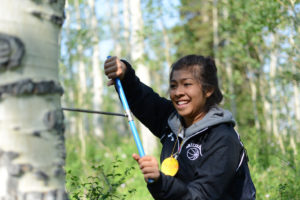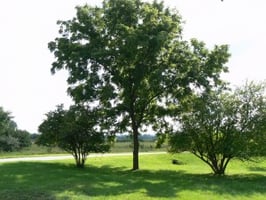From January to August we have now donated 1,150 trees to our public lands with the Arbor Day...
How Old is this Tree? Questions for an Arborist.
Tree removals aren’t all we do! Part of being a certified arborist is answering lots of tree questions. And we don’t mind that at all, we want you thinking about trees and asking questions. Knowledgable homeowners keep trees and our ecosystem healthy.
One of the more common questions that we find ourselves facing is the legendary “How old is my tree?“.
This question is a fun one to answer and you can even make a pretty educated guess. As most people know the best way to determine a tree’s age is to complete a tree removal and then count the rings on the once living tree. Well, we are definitely not going to cut down trees just to know the age!

An increment borer can tell you more information on the age of a tree, but there is a price. More holes in a tree means more opportunity for pests and disease.
You could also use an increment borer to drill into the tree and pull a core out from the hollow bit to count the rings. With this method and arboris tcan give you the exact age IF they drill perfectly to the center ring of the tree. Sometimes, especially on leaning trees, it can be difficult to predict where the center ring is and you may have to drill multiple holes to finally hit the center. Damaging insects and pathogens would love the tree to have more holes, so this isn’t really a great idea either.
The first and most important thing to remember is that size does not directly relate to age. The size of the rings can vary. A fast growing tree will have large rings and a slow growing tree will have very small tight rings. 10 large rings might make a 10” diameter tree and 10 small rings might make a 1” diameter tree. Two totally different sized trees may be the exact same age. Many factors can determine a trees growth rate.
So then we are left with the old fashioned educated guess, leaving the arborist with no choice but to use his detective skills. First it is important to figure out what species of tree we are working with and what are the typical growth traits of this tree. Some trees such as Tulip Poplar, White Pine, Silver Maple are fast growing trees common to the St. Louis area. Oaks, Hickories, and Osage Orange. Second, it is important to know the environment this tree is growing in. A tree growing with full sunlight and a large zone of healthy soil will grow much faster than one that has been in the shade with a small root zone. This can be determined by looking at the shape of the canopy. Trees with symmetrical wide canopies have likely been receiving full sunlight for a long time. Trees with lopsided or asymmetrycal canopies have probably been shaded by other trees or obstructions for a significant portion of their lives leaving them with less of an opportunity to produce the carbohydrates needed to grow big.
Do you have any tree questions? Email them to info@stltreepros.com and maybe we can answer them here on the blog! Thanks for reading.
Need more than just a question answered? Our estimates are free, request one here.



